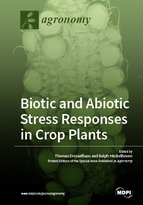Biotic and Abiotic Stress Responses in Crop Plants
A special issue of Agronomy (ISSN 2073-4395). This special issue belongs to the section "Crop Breeding and Genetics".
Deadline for manuscript submissions: closed (1 August 2018) | Viewed by 128633
Special Issue Editors
Interests: flowering time; germline development and function; fertilization mechanisms; haploidy induction; speciation mechanisms; early seed development; heat and infection stress during reproduction; gene regulation; CRPs; signaling mechanisms; RNPs; cell polarity
Interests: plant–microbe interactions; pattern-triggered immunity; disease susceptibility; cellular defense responses; powdery mildew; Fusarium spp.; Pseudomonas spp.; ROP GTPases; receptor-like kinases; programmed cell death; signal transduction; cytoskeleton
Special Issue Information
Dear Colleagues,
While the demands for crop products continues to increase strongly, agricultural productivity is threatened by various stress factors, often associated with global warming. To sustain and improve yield, it is necessary to understand how plants respond to various stresses, and to use the generated knowledge in modern breeding programs. Most knowledge regarding the molecular mechanisms associated with stress responses has been obtained from investigations using the model plant Arabidopsis thaliana. Stress hormones, such as abscisic acid, jasmonic acid, and salicylic acid, have been shown to play key roles in defense responses against abiotic and biotic stresses. More recently, evidence that growth-regulating plant hormones are also involved in stress responses has been accumulating. Epigenetic regulation at the DNA and histone level, and gene regulation by small non-coding RNAs also appear to be important. Many approaches have used mutant screens, as well as next generation sequencing approaches, to identify key players and mechanisms of plant responses to the environment. However, it is often unclear to which extent the elucidated mechanisms also operate in crops.
This Special Issue, therefore, seeks contributions reporting how crop plant species respond to various abiotic stresses, such as drought, heat, cold, flooding, and salinity, as well as biotic stimuli during microbial infections. It welcomes reviews, perspectives, and original articles, and its focus is on our molecular understanding of biotic and abiotic stress responses in crops, highlighting, among other aspects, the role of stress hormones, signaling mechanisms, and changes in gene expression patterns and their regulation. Approaches and ideas to achieve stress tolerance and to maintain yield stability of agricultural crops during stress periods are of specific interest. These include perspectives on how knowledge from model plants can be utilized to facilitate crop-plant breeding and biotechnology.
Prof. Dr. Thomas Dresselhaus
Prof. Dr. Ralph Hückelhoven
Guest Editors
Manuscript Submission Information
Manuscripts should be submitted online at www.mdpi.com by registering and logging in to this website. Once you are registered, click here to go to the submission form. Manuscripts can be submitted until the deadline. All submissions that pass pre-check are peer-reviewed. Accepted papers will be published continuously in the journal (as soon as accepted) and will be listed together on the special issue website. Research articles, review articles as well as short communications are invited. For planned papers, a title and short abstract (about 100 words) can be sent to the Editorial Office for announcement on this website.
Submitted manuscripts should not have been published previously, nor be under consideration for publication elsewhere (except conference proceedings papers). All manuscripts are thoroughly refereed through a single-blind peer-review process. A guide for authors and other relevant information for submission of manuscripts is available on the Instructions for Authors page. Agronomy is an international peer-reviewed open access monthly journal published by MDPI.
Please visit the Instructions for Authors page before submitting a manuscript. The Article Processing Charge (APC) for publication in this open access journal is 2600 CHF (Swiss Francs). Submitted papers should be well formatted and use good English. Authors may use MDPI's English editing service prior to publication or during author revisions.
Keywords
- Agricultural crops
- Heat and drought stress
- Cold stress
- Salinity and flooding
- Plant immunity
- Disease susceptibility and resistance
- Stress hormones
- Gene regulation
- Signaling mechanisms
- Stress tolerance breeding
- Resistance breeding
- Biotechnology







